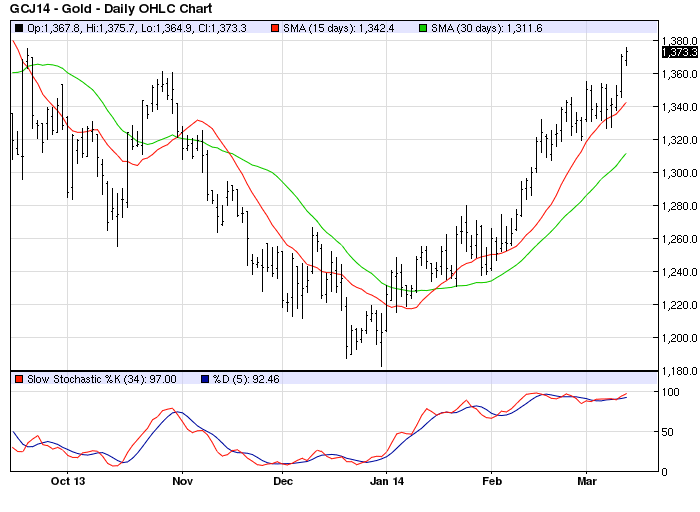Morgan Stanley was the latest to enter the fray on Monday when it lowered its gold price forecast for 2014 and 2015 in a research report. The group based its lower forecast on the expected impact of reduced monetary stimulus combined with increased regulatory pressure on investment banks to reduce the scale of proprietary commodities trading.
Morgan noted that while demand for physical gold remained strong in China, imports to India were low. Moreover, Morgan asserted that last year’s sell-off of assets by gold ETFs nullified the strength provided by increased Chinese demand. “The lower price environment will pose significant challenges for gold miners given the substantial rise in costs over the past decade,” the bank said. Morgan Stanley lowered its 2014 average price forecast for gold by 11.6 percent to $1,160/oz, and cut its average 2015 gold price forecast by 12.5 percent to $1,138/oz. Let’s examine the two basic assumptions behind Morgan Stanley’s bearish gold forecast for 2014-2015. The first negative assumption is that reduced monetary stimulus will result in lower gold prices. We’ve already discovered in previous reports the fallacy of this argument. Indeed, ever since the U.S. Federal Reserve announced that it be tapering its asset purchases the gold price has gone up in contrast to what most institutional analysts predicted. This is because quantitative easing (QE) isn’t a major driver for the gold price; volatility and investor uncertainty are the main drivers. In the final portion of the deflationary long wave, fear and uncertainty are the main reasons for owning gold. As long as investor trepidation remains, any increase in economic fragility or geopolitical tension (e.g. China, Russia, Ukraine) will only serve to underscore gold’s attractiveness as a financial save haven. In just the last two-and-half months we’ve seen how a stock market correction, an emerging markets scare, military tensions in Eastern Europe, and economic uncertainty in China have combined to lift the yellow metal to its highest levels since last September. All the while the Fed has been reducing the pace of its mortgage purchases and otherwise shrinking its QE policy. 
Morgan Stanley’s second reason for embracing a bearish 2014-15 gold outlook are the new rules restricting proprietary commodities trading among investment banks. Yet even before these rules were implemented banks had already begun shrinking their commodity trading desks. Indeed, bank trading is no longer even a central pillar behind gold price momentum and hasn’t been for a long time. This, then, is also a deceptive reason for expecting gold to underperform in the coming 1-2 years. With the gold price having rallied some 15 percent off last year’s lows, the leading institutional banks are wiping a lot of egg off their faces. Goldman Sachs, arguably the most respectable of the big Wall Street banks, is bending over backwards of late in making excuses for its blown gold call from late last year. In its latest report to its clients, Goldman asserts its continued belief that the gold rally will soon fade despite renewed buying among hedge funds. According to U.S. government data, hedge funds and other speculators increased bullish bets on gold for a fourth consecutive week and are currently the most bullish they’ve been since December 2012. The net-long position in gold climbed 3.8 percent to 118,241 futures and options in the week ended March 4, according to the Commodity Futures Trading Commission (CFTC). Short holdings, by contrast, were down 15 percent to 26,321, the lowest since October. Goldman’s chief commodities analyst, Jeffrey Currie, said that turmoil between Russia and Ukraine doesn’t alter the firm’s bearish view on gold. He also told Bloomberg that lower mining costs means that it’s “more probable than it was six months ago that prices would drop below $1,000.” Goldman seems to be grasping at straws in its attempt at rationalizing a blown bearish call. Moreover, the firm believes a strengthening dollar will weigh against the metals based on the expectation of accelerating U.S. economic strength. Yet the dollar has shown no sign of strengthening as yet but instead continues to grind lower and is testing a major low.

In contrast to Goldman and the Wall Street banks, billionaire hedge-fund manager John Paulson, who holds the biggest stake in SPDR Gold Trust (GLD), reported gains in his firm’s bullish gold strategies last month. Holdings through gold ETFs rose in February for the first time since 2012. Assets in the GLD, world’s largest gold ETF, are up 0.9 percent in 2014 following a 41 drop drop in 2013 that resulted in a $41.8 billion decline in value.
